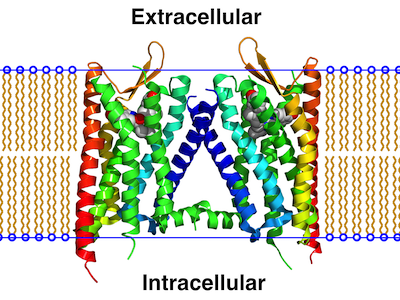Why would you possibly choose to study science or medicine when you could pursue a dazzling career as a classical guitarist or ponder philosophical questions? That was the viewpoint of Solomon Snyder when he was a young high school student. But fortunately for the field of neuroscience, and our understanding of how opiate drugs act in the brain, Snyder let go of those early ideas of glamour and steered himself toward pre-medical courses in college and then into Georgetown University School of Medicine.

Snyder looking at the contents of Erlenmeyer flasks in his lab [Courtesy of Johns Hopkins Media Relations]
Snyder took comfort in this new path by telling himself that he would practice psychiatry, as he indeed ended up doing, since psychiatry was not all that different from studying philosophy. And before long, Snyder found a remarkable passion for science and research. Through his friendship with a US National Institutes of Health (NIH) scientist to whom he was giving guitar lessons, he landed a lab job at the NIH the summer after college. Snyder promptly “commenced a romance with the NIH,” he recounted years ago. After medical school, Snyder obtained another stint at the NIH in the lab of Julius Axelrod, who would win the Nobel Prize about a decade later in 1970 for describing the activity of the neurotransmitter noradrenaline. Snyder diversified his research experiences beyond his initial work studying amino acid metabolism, including taking on sundry projects such as the regulation of the neurotransmitter serotonin.
The time in Axelrod’s lab “imbued me with the science bug,” Snyder says. It also sparked his long love affair with neurotransmitters that eventually led to numerous discoveries about opiates, their receptors and the natural neurotransmitters they mimic. The work earned Snyder, along with Scottish researchers John Hughes and Hans Kosterlitz, the 1978 Albert Lasker Basic Medical Research Award.

Snyder continues to work in the lab today. [Courtesy of Johns Hopkins Media Relations]
When Snyder was setting up his own lab at Johns Hopkins University School of Medicine in the late 1960s, he knew he did not want to merely continue his earlier research. The idea of delving into the neuroscience of drugs was not part of his initial vision. Instead, his lab focused on probing the uptake of dopamine and other neurotransmitters by neurons, using a handy method developed almost by accident.
Snyder’s research soon took a detour when President Richard Nixon declared war on heroin and Jerome Jaffe, a psychiatry professor and Snyder’s old friend, was appointed as drug czar. Snyder helped advise Jaffe on how best to deploy the billions of dollars at his disposal and proposed the formation of Drug Abuse Research Centers under the NIH National Institute of Mental Health (NIMH) to conduct scientific research on drugs.
Perhaps not surprisingly, Johns Hopkins was selected to be one of the new Drug Abuse Research Centers, and Snyder was faced with the difficult question of what they should actually study. As he recalls, “I didn’t know morphine from marijuana.” (Case in point, when Snyder was a young doctor working at the Hopkins psychiatric hospital, he had to be alerted by a hospital aide that one of the patients was actually growing marijuana in the planters throughout the ward.)

Diagram of the opiod receptor [Courtesy of Wikimedia Commons, CC 3.0]
Snyder reasoned that he should start by trying to identify the receptors that opiates — including heroin, morphine, and codeine — were presumably binding to on the surface of neuronal synapses, the parts of nerve cells that communicate with each other. “The receptors are the key components of synapses, and so if you want to understand neurotransmission, you should know about receptors at a molecular level,” Snyder recently explained. At the time, nobody had found any receptors for neurotransmitters in the brain, and nobody, including Snyder, thought it would be possible, mainly because of the vanishingly small fraction of the brain that these receptors make up. (Scientists had just found the nicotinic cholinergic receptor in the electric fish, but that receptor accounts for a whopping 20% of the weight of the fish’s electric organ.) Nevertheless, Snyder and his graduate student Candace Pert forged ahead, taking advantage of the tools that were being developed in the lab in the hunt for the nerve growth factor receptor. Fortuitously, Pedro Cuatrecasas, who occupied the lab next door, had recently identified the insulin receptor and decided to join the pursuit.
Within weeks, Snyder’s lab hit upon both the nerve growth factor receptor and opiate receptor (which we now know is one of several flavors of the opiate receptor family) — a feat that Snyder breezily attributes to “luck.” In rapid succession, the lab then identified parts of the brain where opiate receptors are (and are not) abundant, helping to explain how the drugs affect people who take them; he also went on to show that molecules called enkephalins are found near opiate receptors, providing evidence that they are the body’s natural opiates, and he found chemical differences between heroin and codeine that accounted for their different effects on the body.
Opening Pandora’s Box
His team’s success in finding the first neurotransmitter receptors in the brain also made Snyder think:
“Let’s get other receptors, and maybe that would open the whole Pandora’s box of neurotransmitter-synaptic interactions.”
That is exactly what happened, and to this day Snyder’s lab at Johns Hopkins is trying to determine the receptor for the “big, important drug” cocaine. People have been studying cocaine since Snyder’s early days in Axelrod’s lab, but nobody had ever successfully drilled down to figure out what it does at a molecular level, he explains.
Outside the lab, Snyder is a showman — in addition to playing guitar from a young age, he participated in a radio talent show when he was just 5 years old and later wrote songs for a medical-themed musical during his medical school internship. But for all his flair for performing, the experiments that made Snyder famous, especially the method to identify receptors (adapted from Cuatrecasas’s approach), are strikingly simple. In fact, other scientists critiqued the simplicity, calling it the “Snyder bind-and-grind receptor strategy,” as he recalls. But this did not faze him: “I don’t mind not being sophisticated.” The method, after all, was good enough for the pharmaceutical industry, as many of the major companies used it to search for new drugs. (Snyder also found out years after his lab created the method to study dopamine uptake that Eli Lilly used it in making their blockbuster antidepressant drug Prozac.)

Snyder has pursued many interests — including classical guitar — outside of the lab. [Courtesy of Johns Hopkins Media Relations]
Snyder not only ponders the ways in which drugs affect humans; he also has reflected upon the origins of his own life and career. He suspects that he had the makings of a scientist, despite not having other scientists in his family, because of the creative spirit he got from his mother, who he has referred to as a stage mom — she spearheaded many post-World War II entrepreneurial endeavors in Washington DC, even as she raised Snyder and his siblings. He also credits a knack for organizational thinking which he attributes to his father, a computer programmer for the National Security Agency.
Throughout his career, Snyder has been a leader in both the scientific community and in industry. In the early 1980s, he helped spawn Nova Pharmaceutical Corporation (which has since merged and been bought several times over) to search for receptors. In his view, it is important for academic researchers to get involved in biotech companies to help turn basic scientific findings into therapeutic drugs. Snyder served as president of the Society for Neuroscience in 1980 and managed to both launch the publication of the Journal of Neuroscience and hold the organization together at a time of rapid growth in membership. Still, after all his contributions to neuroscience, Snyder considers himself less a scientist and more a psychiatrist, active in clinical practice at Johns Hopkins while doing some research on the side.
Snyder also took a turn as president of the synagogue that he and his late wife, Elaine, whom he met in medical school and who was a “staunch advocate for the chronically mentally ill,” began attending when their first of two daughters was born. And through it all, Snyder has kept one foot firmly planted in the music world. He is a long-time member of the boards of the Baltimore Symphony Orchestra and the Peabody Institute, where he has been deeply involved in their guitar department.
Although Snyder admits research can be an “all-consuming” undertaking, he has said that juggling a wide range of activities played into his success. As he explains: “Participation in the arts enhances fecundity in scientific discovery. Parenting children involves the same practices as mentoring students.” But in his opinion, even more important than being productive is having fun. “If not, why bother?”
By Carina Storrs
